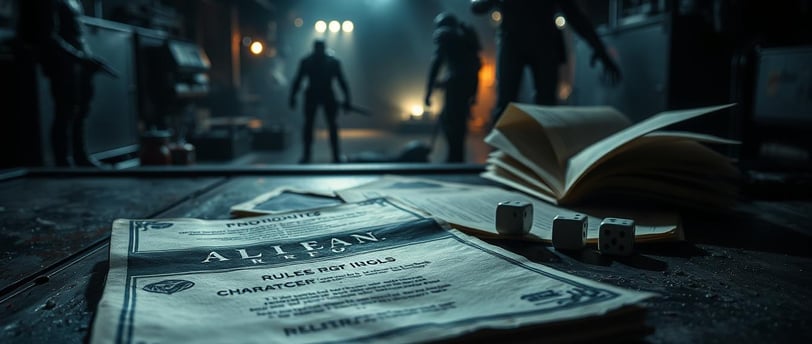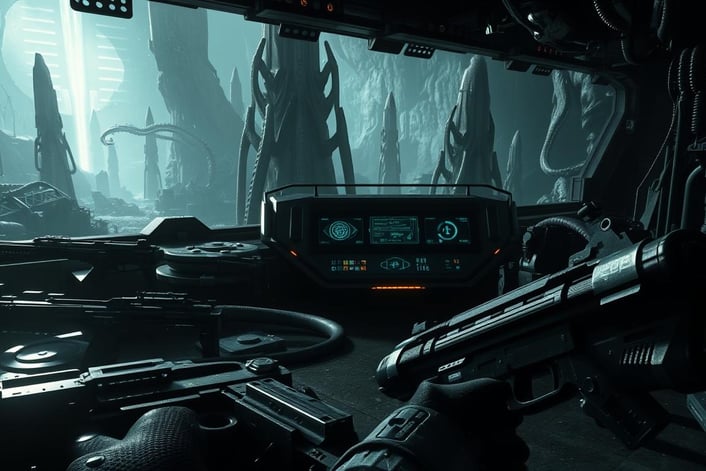Free League's Alien RPG: Embark on a Thrilling Sci-Fi Journey
Step into a universe where space is as deadly as it is vast. Inspired by the iconic Alien film franchise, this tabletop roleplaying experience plunges players into a world of claustrophobic tension and unpredictable threats. The 392-page hardcover rulebook combines cinematic storytelling with richly detailed artwork, creating an atmosphere that’s equal parts awe-inspiring and terrifying. (This post contains affiliate links, I make a small commission for each purchase.)
4/13/20256 min read


Designed for both newcomers and seasoned fans, the game masterfully blends survival horror with strategic decision-making. Its rules prioritize dramatic pacing, forcing teams to balance teamwork and self-preservation. Whether navigating derelict ships or facing extraterrestrial horrors, every choice carries weight.
Recognized with a Gold ENNIE Award in 2020, the system stands out for its immersive design. Players craft unique characters while navigating scenarios that echo the franchise’s signature blend of corporate intrigue and cosmic dread. The core mechanics ensure tension escalates naturally, keeping groups on edge until the final dice roll.
Key Takeaways
Official licensed experience capturing the Alien universe’s suspense
392-page hardcover book packed with artwork and scenarios
Gold ENNIE Award-winning design for immersive gameplay
Rules system emphasizing high-stakes survival decisions
Flexible playstyles from one-shot missions to campaign arcs
Seamless blend of narrative depth and tactical challenges
In-Depth Review: Free League Publishing Alien RPG
The chilling void of deep space sets the stage for a sci-fi nightmare where trust dissolves faster than airlocks. Critics from TheGamer praise the tabletop roleplaying game for capturing the original film series’ DNA—corporate greed, political tensions, and biological terrors that defy human comprehension.

Background and Setting
Three rival governments clash over resources while mega-corporations weaponize secrets. This unstable galaxy mirrors the horror classics, but with fresh layers of interstellar diplomacy. Dicebreaker notes how the rulebook weaves lore into every scenario, making abandoned colonies feel like tinderboxes waiting to ignite.
Core Themes and the Experience of Horror
Stress mechanics amplify dread as players manage dwindling supplies and paranoia. One wrong move triggers cascading failures—a design choice that earned the Gold ENNIE award. The system doesn’t just simulate fear; it weaponizes uncertainty through timed missions and hidden agendas.
Campaign and cinematic modes offer distinct flavors of terror. Multi-session arcs let groups unravel conspiracies, while single-shot scenarios replicate the films’ breakneck pacing. Industry reviewers highlight how characters evolve through trauma, creating stories as memorable as they are brutal.
Immersive Sci‑Fi Experience: Gameplay and Rules
Survival in deep space demands more than luck—it requires a system built for chaos. The Alien RPG modifies Free League’s Year Zero Engine, streamlining rules to amplify dread. This foundation keeps gameplay accessible while letting tension escalate through clever mechanical twists.


Adaptation of the Year Zero Engine
The engine uses d6 dice pools tied to character skills and attributes. Each roll combines base dice with bonus modifiers, but here’s the catch: every failed attempt adds a stress die to future rolls. These crimson cubes boost success chances… until they trigger catastrophic panic effects. One reviewer noted, “It turns desperation into a tactical gamble—you’re always one bad roll from disaster.”
Dice System and Tension‑Building Mechanics
Stress isn’t just a number—it’s a ticking bomb. When stress dice show a “1,” players face escalating consequences like misfiring weapons or betraying allies. The game master tracks a hidden “panic level,” ensuring threats feel unpredictable. This blend of simplicity and depth lets groups focus on storytelling without drowning in rules.
Key features driving the horror experience:
Gradual stress accumulation mirroring character fraying nerves
Panic tables that escalate scenarios into chaos
Cinematic “pushed roll” option for high-risk actions
The mechanics force tough choices: Do you risk a reroll knowing stress might doom the team? Such decisions cement the sci-fi setting’s brutal realism, making every mission a fight against both monsters and madness.
Campaign vs Cinematic Mode: Tailoring Your Adventure
The system offers two distinct pathways through its sci-fi nightmares, letting groups choose their flavor of terror. Both modes use the same rules foundation but twist gameplay to create radically different experiences. Reviewers praise this flexibility, noting it accommodates casual players and lore-hungry veterans equally.
Cinematic Play for Fast-Paced, High-Stakes Scenarios
Pre-generated characters and timed missions replicate the films’ breakneck pacing. Sessions often end in bloodbaths—Dicebreaker calls it “a masterclass in controlled chaos.” The game ramps tension through:
Secret agendas that pit teammates against each other
Countdown clocks for oxygen levels or reactor meltdowns
Panic rolls that escalate every failed skill check
One player remarked, “You’re not surviving—you’re racing toward the most dramatic death possible.”
Campaign Mode for Extended, Narrative-Driven Sessions
Persistent crews face evolving threats across star systems. Characters gain scars (physical and psychological) that shape future decisions. The campaign structure shines in:
Long-term resource management between missions
Corporate betrayals that unfold over multiple sessions
Customizable ship upgrades with risky trade-offs
This mode rewards strategic thinking but never lets players forget the lurking fear. As stress accumulates, even veteran groups unravel—proving the Gold ENNIE-winning design works at any timescale.
Visuals, Storytelling, and Game Design Elements
Visual design becomes a silent storyteller in this sci-fi odyssey. The core book bursts with industrial schematics and eerie landscapes that mirror the franchise’s signature aesthetic. Every page feels like a window into a universe where horror lurks behind sterile corridors and flickering holograms.


Illustrations, Graphic Design, and Atmospheric Detail
Artists replicate the retro-futurism of the Alien films through rust-stained machinery and biomechanical nightmares. Maps of derelict ships include air vent shortcuts and malfunctioning security systems—details that transform game sessions into tactical puzzles. Character sheets mimic corporate ID badges, deepening immersion during roleplaying moments.
Supplementary materials elevate the experience. Custom stress dice glow under blacklight, while mission trackers use color-coded alerts to heighten tension. One user noted, “The props don’t just look cool—they become tools for survival.”
Clear typography and intuitive icons ensure quick reference during play. Flowcharts for panic reactions and infection stages let players resolve crises without flipping through pages. This balance of style and function keeps the campaign flowing smoothly, even as paranoia mounts.
From space marine armor designs to xenomorph life cycle diagrams, every visual reinforces the story. The result? A tabletop experience where aesthetics and mechanics fuse into unforgettable sci-fi terror.
Conclusion
Navigating the cold expanse of uncharted galaxies becomes visceral in this tabletop experience. The system’s Gold ENNIE Award-winning design proves why it stands tall among sci-fi titles, blending nerve-wracking rules with rich storytelling. Every session transforms players into desperate survivors, where space stations hum with unseen dangers and trust fractures faster than airlocks.
Whether choosing campaign depth or cinematic intensity, the game delivers relentless horror. Its core mechanics force groups to balance strategy against escalating panic—a dance of logic and primal instinct. The 392-page rulebook serves as both guide and art piece, its industrial-chic layouts mirroring the Alien series’ aesthetic.
Newcomers and veterans alike find value in its layered design. Tactical resource management collides with character-driven drama, creating stories where characters evolve through trauma rather than triumph. This isn’t just roleplaying—it’s survival theater.
Free League Publishing crafts more than a game; they build pressure cookers of interstellar dread. Ready your dice and steady your nerves—the void awaits.
FAQ
What makes the game’s setting stand out compared to other sci-fi tabletop titles?
The setting immerses players in the isolated, corporate-dominated Frontier, blending gritty survival with cosmic terror. It captures the essence of the films through lore-driven locations, unpredictable threats, and a focus on human vulnerability against unknown horrors.
How does Cinematic Mode differ from Campaign Mode?
Cinematic Mode offers short, intense sessions modeled after the films’ structure, with pre-made scenarios and high stakes. Campaign Mode allows for long-term storytelling, letting crews develop over time while navigating political intrigue and resource scarcity.
How does the Year Zero Engine enhance tension during gameplay?
The system uses stress dice to escalate risks—rolling doubles triggers complications, like malfunctioning gear or attracting enemies. This mirrors the films’ escalating panic, forcing tough choices between survival and teamwork.
Can players create custom characters, or are they limited to pre-made roles?
Both options exist. Cinematic play often uses pre-generated roles for tight narratives, while Campaign Mode encourages building unique characters with personal agendas, skills, and flaws that impact group dynamics.
How do the rules handle horror elements without relying on shock value?
Mechanics like stealth rolls, limited resources, and hidden agendas build dread. The stress system forces players into desperation, while xenomorph behaviors—tracked secretly by the GM—keep threats unpredictable and cerebral.
Are expansions or additional scenarios available beyond the core rulebook?
Yes, supplements like Colonial Marines Operations Manual and Destroyer of Worlds add depth. These introduce new factions, gear, and story arcs, expanding the Frontier’s lore and gameplay options.
What visual elements help immerse players in the atmosphere?
The book features stark, retro-futuristic art inspired by the films, including blueprints, in-universe ads, and claustrophobic ship layouts. These details reinforce the gritty, industrial aesthetic central to the franchise.
Is the game suitable for newcomers to tabletop roleplaying?
Yes. The rules prioritize narrative over complexity, and Cinematic Mode’s structured scenarios help ease groups into the system. Pre-made scenarios include clear pacing guides for GMs.
How does combat balance tension with player agency?
Fast, lethal encounters discourage direct fights. Players must use traps, distractions, or environmental hazards—emphasizing creativity over brute force, much like the films’ survival strategies.
Has the title received any notable industry recognition?
It won the 2020 Gold ENnie Award for Best Game, praised for its faithful adaptation of the franchise and innovative stress mechanics that enhance collaborative storytelling.
